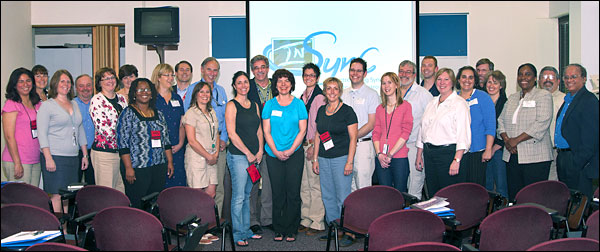InSynC Workshop Trains New Batch of NSLS Users
June 3, 2011
The second Introducing Synchrotrons into the Classroom (InSynC) workshop drew a new batch of 22 local — and for the first time, international — teachers who want to learn how to use Brookhaven’s National Synchrotron Light Source (NSLS) with their students.

Participants in the 2011 InSynC workshop
Launched last summer by the Photon Sciences Directorate and Brookhaven's Office of Educational Programs (OEP) in collaboration with scientists from the University of Chicago, InSynC enables teachers and students to gain onsite and remote access to NSLS through a competitive, peer-reviewed proposal process. A goal of the program is to train both teachers and students to formulate a hypothesis-driven scientific problem and have the opportunity to use the nation’s large user facilities to solve them.
InSynC is also an opportunity to introduce synchrotron science to students at a young age. “We are seeing a shortage and future demand for scientists, engineers, and technicians that are trained to work at a synchrotron,” said NSLS scientist Lisa Miller. “Introduction to these facilities early in academic learning is a way to motivate students to pursue this field of science.”
Last year, the program trained 17 middle school and high school science teachers, six who have developed research proposals to use the massive machine with their students. Since InSynC began, five classrooms have used NSLS to perform experiments on materials ranging from tap water to tobacco.
The second annual workshop, held at the tail end of the NSLS-Center for Functional Nanomaterials Users’ Meeting on May 25-26, included presentations on the basics of synchrotron techniques and webconferencing, a tour of the experimental floor, hands-on beamline activities, and a tutorial on writing research proposals.
Participants also heard from teachers who recently participated in the program. Longwood High School teacher Lucinda Hemmick told the new InSynC teachers that the best thing to happen to her students was not having their proposal selected to receive beam time the first time around.
The first batch of InSynC participants included a group of students from Islip Middle School who used the massive machine to study the effectiveness of different water filters. Here's their story.
“At first, they were crushed,” she said. “But it’s what a real scientist goes through. Even though I had to scrape them up, eventually they were like ‘this is OK.’”
After discussing their proposal’s strengths and weaknesses with NSLS scientists, the Longwood students refined and resubmitted it for the following cycle of beam time. That time, the proposal received a higher score, and the students were allocated beam time to run their experiment — comparing the toxins in tobacco from commercial and organic cigarettes — with an X-ray fluorescence microscope at NSLS in April.
They found some surprises: Polonium, which may lead to lung cancer, wasn’t found in either of the tobacco samples. And the organic cigarettes actually contained higher levels of potentially toxic elements. The students presented their results, which opened up as many new questions as answers, at the Users’ Meeting poster session.
“They had a great time — they didn’t want to go home,” Hemmick said. “Now, they’re the experts.”
The tobacco experiment is one of many examples of research that teachers can conduct with synchrotron techniques. Possible subject areas for InSynC participants include energy, environmental sciences, geosciences, plant biology, biomedicine, structural biology, and robotics.
In its second year, InSynC is starting to expand from Long Island classrooms to those around the nation. The program is gaining interest from Argonne National Laboratory and SLAC National Accelerator Laboratory, both of which host large light sources like NSLS. This year’s workshop also attracted the first international participant, Cassilda Brookes, a science teacher at Ivanna Eudora Kean High School in St. Thomas, Virgin Islands.
“Because we’re so far away, we don’t usually have the opportunity to use big research facilities like NSLS,” said Brookes, who learned about InSynC from a University of the Virgin Islands colleague who has learned about Brookhaven’s research prospects through INCREASE. “But this program can help my students make an initial acquaintance with the light source, and that’s something that could greatly help them down the road.”
Brookes already has a couple of potential research ideas for her students to explore, from chemical releases in rum distilleries on St. Croix to the makeup of coral reefs.
The proposal submission deadline for beam time between September 1 and December 31, 2011 is July 15.
Support for InSynC is provided by the Office of Workforce Development for Teachers and Students within the U.S. Department of Energy Office of Science.
2011-2399 | INT/EXT | Newsroom









